 |
|
The
March Retreat
by
General Sir Hubert Gough
G.C.M.G., K.C.B., K.G.V.O., etc.
|
|
 |
|
This is
the 1934 First Edition |
 |
|
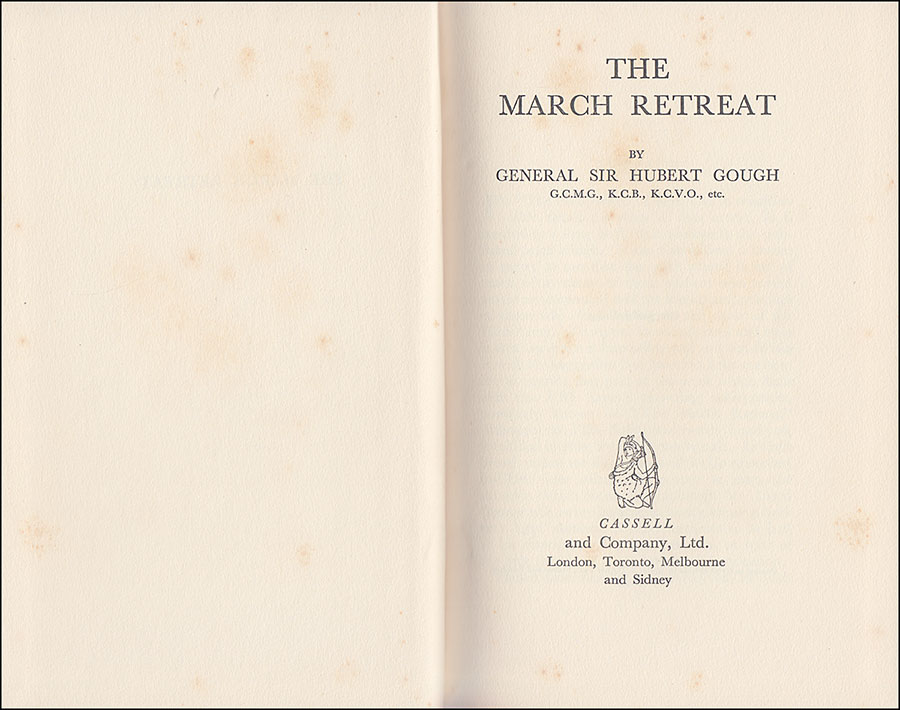
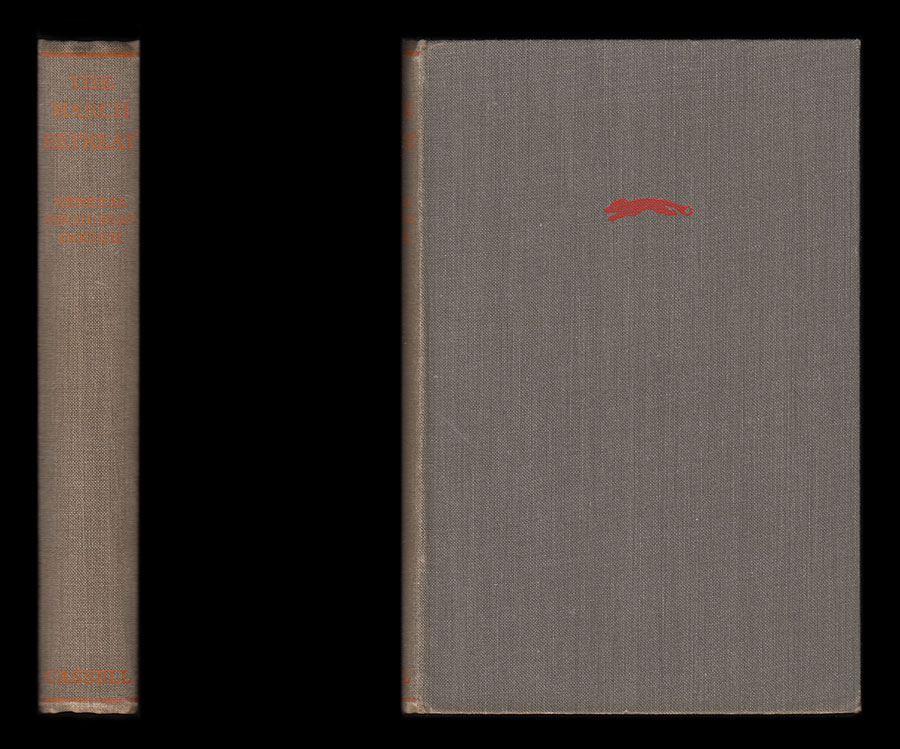
Front cover and spine
Further images of this book are
shown below
|
|
 |
|
 |
 |
|
|
|
Publisher and place of
publication |
|
Dimensions in inches (to
the nearest quarter-inch) |
|
London: Cassell and Company Ltd |
|
5 inches wide x 7½ inches tall |
| |
|
|
|
Edition |
|
Length |
|
1934 First Edition |
|
[vii] + 216 pages |
| |
|
|
|
Condition of covers |
|
Internal condition |
|
Original grey cloth blocked in red. The covers
are rubbed and dull with some discolouration to the cloth noticeable around
the edges, and have also bowed out somewhat. The spine has faded and is
extremely dull so that the title and author details are virtually illegible.
The is also some discolouration to the spine and a tiny indentation (under
the "H" in "GOUGH"). The spine ends and corners are bumped and slightly
frayed. There are some indentations along the edges of the boards. |
|
There is offsetting to the end-papers
(evenly-shaped areas of discolouration caused by the original dust-jacket
which is no longer present). The paper has tanned with age and there is
widespread scattered, and occasionally heavy, foxing. The edge of the text block is dust-stained and foxed
with the foxing extending into the margins. The sketch maps are slightly
torn at the stub. |
| |
|
|
|
Dust-jacket present? |
|
Other
comments |
|
No |
|
Overall, a reasonable example of the First Edition,
in dull covers and with scattered, and sometimes heavy, foxing. |
| |
|
|
|
Illustrations,
maps, etc |
|
Contents |
|
There are five sketch maps : please see below for details |
|
Please see below for details |
| |
|
|
|
Post & shipping
information |
|
Payment options |
|
The packed weight is approximately
500 grams.
Full shipping/postage information is
provided in a panel
at the end of this listing.
 |
|
Payment options
:
-
UK buyers: cheque (in
GBP), debit card, credit card (Visa, MasterCard but
not Amex), PayPal
-
International buyers: credit card
(Visa, MasterCard but not Amex), PayPal
Full payment information is provided in a
panel at the end of this listing. |
|
|
 |
|
  |
|
 |
 |
|
The March Retreat
Contents
1. The Approach of the Storm
2. The Battle of St. Quentin
Appendix
Index
Sketch maps
1. The Fifth Army Area. March 1918
2. The Order of Battle. 21st March 1918
3. 21st, 22nd and 23rd March 1918
4. 24th and 25th March 1918
5. 26th, 27th and 28th March 1918
|
|
 |
 |
|
The March Retreat
Preface
IN " The Fifth Army" I have told in
considerable detail the story of that army. It is inevitably a long
book and necessarily the published price is high. It has always been
a matter of regret to me that the price placed it out of reach of so
many of those soldiers who served under my command and the friends
and relations of those who died fighting in the ranks of the Fifth
Army. To reprint the whole book and issue it at a low price is
impossible and so I am falling in with the suggestion that has often
been made to me to reprint that part of the work which deals with
the Fifth Army's crowning achievement, popularly known as " The
March Retreat." Although the Fifth Army was nearly destroyed, it
fulfilled its role, it carried out its task. In their broad outline
the dispositions of the Commander-in-Chief were suited and proper to
meet the situation which faced him, although Mr. Lloyd George will
never be able to justify keeping back such large numbers of
reinforcements as he had at his disposal in England, and this, in
spite of the fact that he is a master of self-justification.
Thus it arose that the Fifth Army was left with a most dangerously
thin line to face the great cyclone which all knew was coming. It
was necessary for the supreme command to gain time, to safeguard the
Channel Ports, to husband its resources and to exhaust the enemies'
strength, and this terribly difficult role was given to the Fifth
Army.
The German Army, on the other hand, knew that this was their last
throw, and every resource which great generalship and great soldiers
were capable of was called in to ensure a decisive and final
victory. By what splendid, almost superhuman efforts, with what
long-enduring heroism and steadfastness, the officers and men of the
Fifth Army stemmed that great flood, tore hope and faith from the
resolute hearts of the German soldiers and eventually left them as
exhausted as ourselves, are related in these pages.
The British Commander-in-Chief meanwhile had economized his forces
and with many divisions in hand was able to make the great
counter-stroke some months later which resulted in victory for the
Allies. As the late Lord Birkenhead said in his book, " Turning
Points of History," as a result of the triumph in retreat of the
Fifth Army " Amiens was saved ; so was Paris ; so were the Channel
Ports. So was France. So was England."
|
|
 |
 |
|
The March Retreat
The Approach of the Storm
HAIG had decided to bring the Battles
of Ypres to a close. The Fifth Army was once again withdrawn, to be
launched into another maelstrom, fiercer and more desperate than any
which it had as yet encountered.
By the 2nd of November 1917, we handed the area of the II Corps back
to the Second Army. This Army made another attack on Passchendaele
on November 6, in which we took no part beyond supporting it with
our artillery, and on November 14 our Head-quarters in the north
closed and we opened at Dury, south of Amiens, where we remained
about a month in G.H.Q,. Reserve.
During this period of waiting, Byng brought off his successful
surprise with tanks in the direction of Cambrai, capturing about 100
German guns.
I was on leave at the time and this
success caused immense excitement and rejoicings at home. For the
first time in the war bells were rung all over the country. But the
enemy command was not long in striking back, and within a few days
the Germans attacked Byng at his weakest spot, captured 100 guns
from him, and inflicted heavy casualties on his troops.
As a surprise Byng's attack was brilliantly executed. It might
indeed have produced even greater results, and Cambrai itself could
have been captured. Nevertheless, there were not sufficient troops
at hand to gain any decisive results, and some critics are inclined
to think that it was, in consequence, a wasted effort, but the
constant demands of the French for activity on our part cannot be
overlooked, and this was but one more incident in the long-drawn
British effort.
No definite orders about the future of the Fifth Army were at first
given to its Staff, but by the end of November we were able to make
a good guess that our destination was the French front on the right
of the Third Army. Up to date this had been a quiet sector and was
lightly held by two French corps only ; but though quiet at the
moment, it was a considerable addition to the British front—about
twenty-eight miles—to which Haig very naturally objected and against
which he strongly protested.
The French argument was that the share of the front to be held by
them and the British should be calculated principally on the mileage
of the total front. Strategical reasons were not considered ; the
vital importance of the Channel Ports to Great Britain in general
and the British Army in particular was overlooked, and the strength
of the German Army opposite the British as compared to its strength
on the French front received little or no consideration : nor did
the fact that serious fighting was impossible on more than half of
the front of the French Army—in the semi-mountainous country of the
Vosges, behind which lay the great fortresses.
Our Mission at French G.Q..G., however, strongly espoused the French
view, and Lloyd George and his Cabinet having more confidence in the
French Command than in Haig, the latter's protests were over-ridden
and we eventually had to take over the whole of this great increase
of front. The results which quickly followed placed the British Army
in the greatest peril, at the same time thoroughly shaking the
confidence and nerve of the Cabinet at home when it awoke by the end
of March to the full consequences of its own decision.
By the 13th of December we found ourselves at Villers-Bretonneux,
and the Fifth Army, instead of taking over at once from the French,
was directed to take over the VII Corps and the Cavalry Corps on the
right of the Third Army. This gave the Fifth Army a front of about
twelve miles to begin with, down to the Omignon River, with the
16th, 21st and 9th Divisions on the VII Corps front, under General
Sir T. Snow on the left, and five cavalry divisions and the 24th
Division on the Cavalry Corps front, under Sir Charles Kavanagh on
the right.
I found on taking over my new front that the enemy was active in
making raids and took a prisoner or two from us regularly, several
nights a week, and this was the first sign which came to my notice
that our front was likely to be the one selected for attack by the
Germans.
The trench system was in a very neglected state. On some parts of
the front there was no continuous line, no dugouts or observation
posts, and communication trenches were few and provided inadequate
cover.
Administratively, especially to the south towards Barisis, the area
was very awkward. It had naturally been organized to receive from
and to deliver towards Paris. It had now to face towards the British
centres of activity, a change which caused much thought and
constructive work to those concerned.
During 1917 the policy of the British Army had been entirely
offensive, and all its resources in engineers, material, etc., had
been devoted to dealing with this side of the operations. Defensive
measures, therefore, had been much neglected.
On the first day that I drove out of my Headquarters to go to the
front, I saw to my surprise parties of French civilians busy filling
in trenches and removing wire along a line which ran about a mile on
the east of the village of Villers-Bretonneux. This line was part of
the defences of Amiens, which had been elaborately constructed and
heavily wired nearly two years previously and were still in an
excellent state. The agricultural population, however, was anxious
to bring all this land back into cultivation, and its appeals had
been yielded to. The choice of the moment for granting this
concession was ill-advised, for the collapse of Russia had made the
prospect of a great German attack almost a certainty, and it was no
time for demolishing good defences. Almost my first act, therefore,
on taking over this sector was to stop all further demolition of
this line, and to commence its reconstruction. It was well I did so,
for it was on this line that " Carey's Force " stood—the last
reserve scraped together by the Fifth Army for the defence of the
battle front at the end of March 1918.
By December 17 very full and detailed instructions were issued for
the organization of our line defensively, and for the conduct of the
troops in case of attack, and the next day the Army Staff had a
conference which dealt with the improvement and increase of
trenches, railways, bridges, roads and organization of the necessary
labour.
There was a great deal which required attention and work—and with
the weak divisions and extended fronts it was very difficult to
provide sufficient labour for everything . . .
|
|
 |
|
  |
 |
|

Please note: to avoid opening the book out, with the
risk of damaging the spine, some of the pages were slightly raised on the
inner edge when being scanned, which has resulted in some blurring to the
text and a
shadow on the inside edge of the final images. Colour reproduction is shown
as accurately as possible but please be aware that some colours
are difficult to scan and may result in a slight variation from
the colour shown below to the actual colour.
In line with eBay guidelines on picture sizes, some of the illustrations may
be shown enlarged for greater detail and clarity.

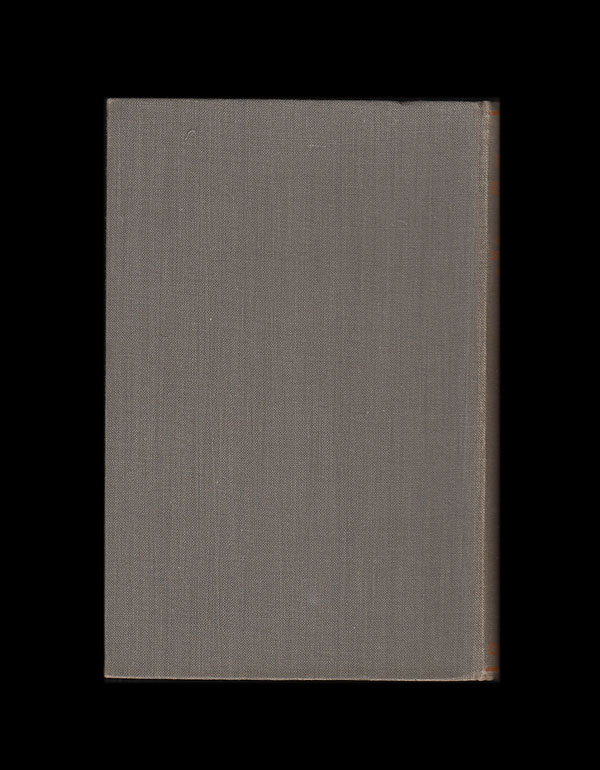


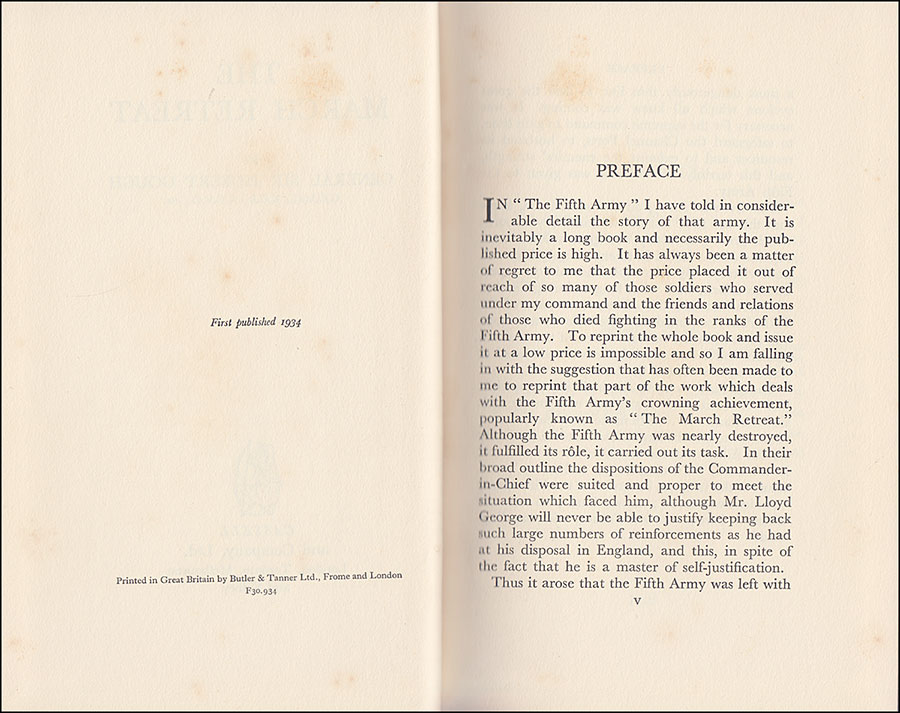
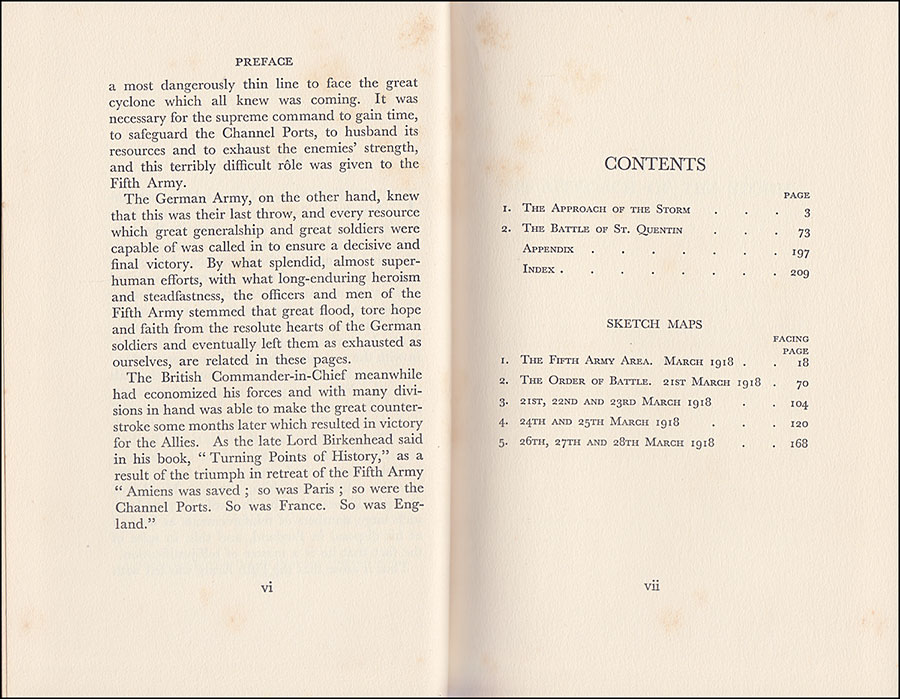
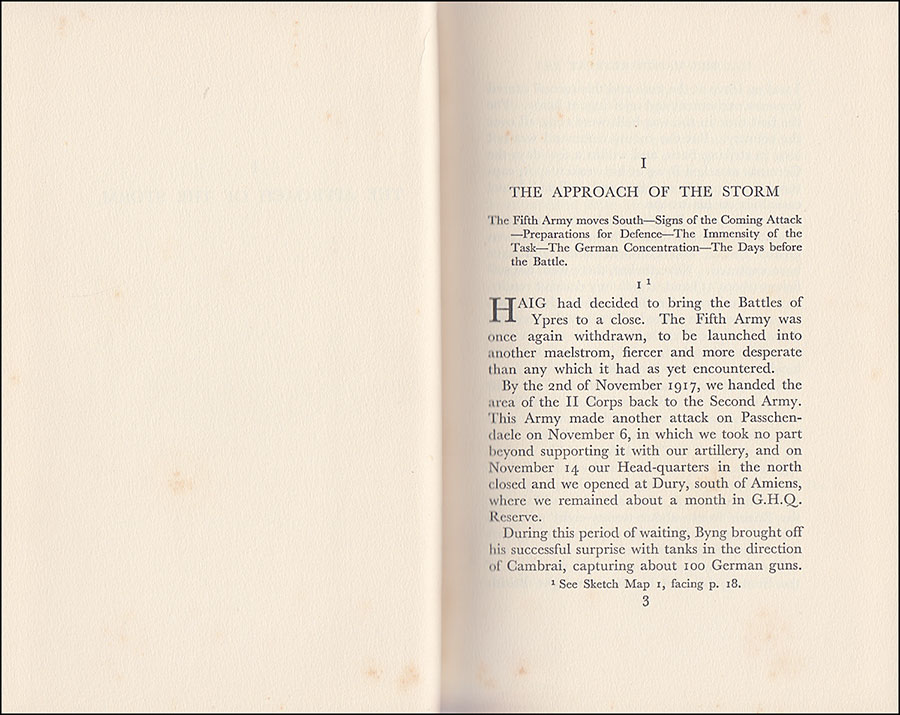
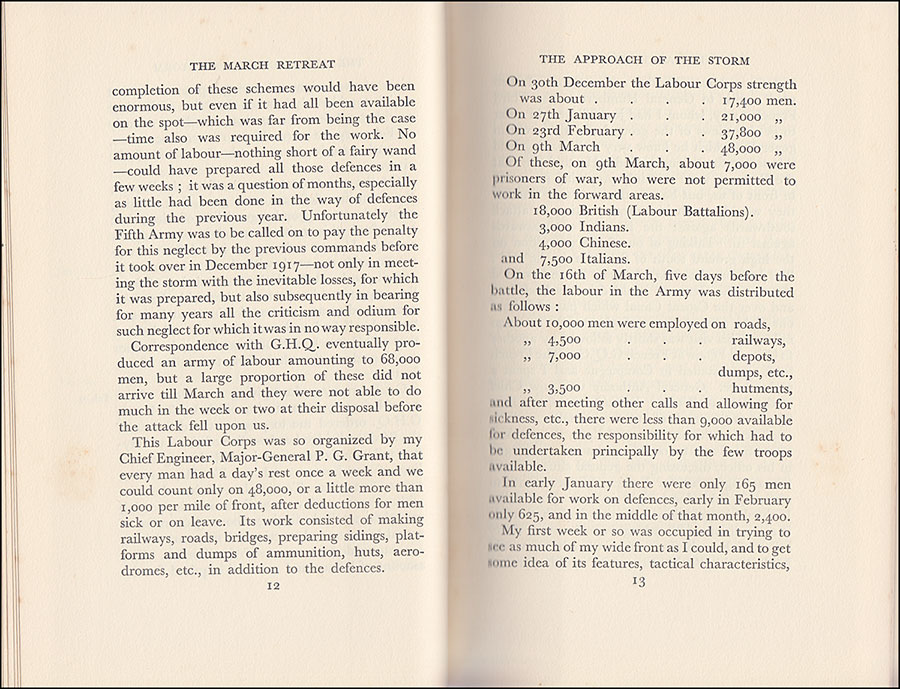
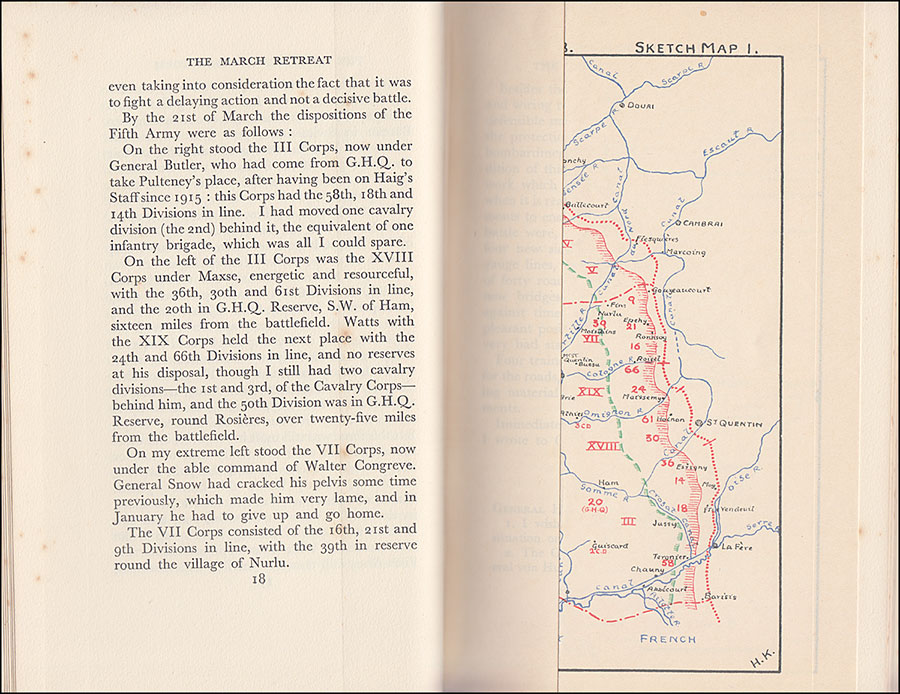
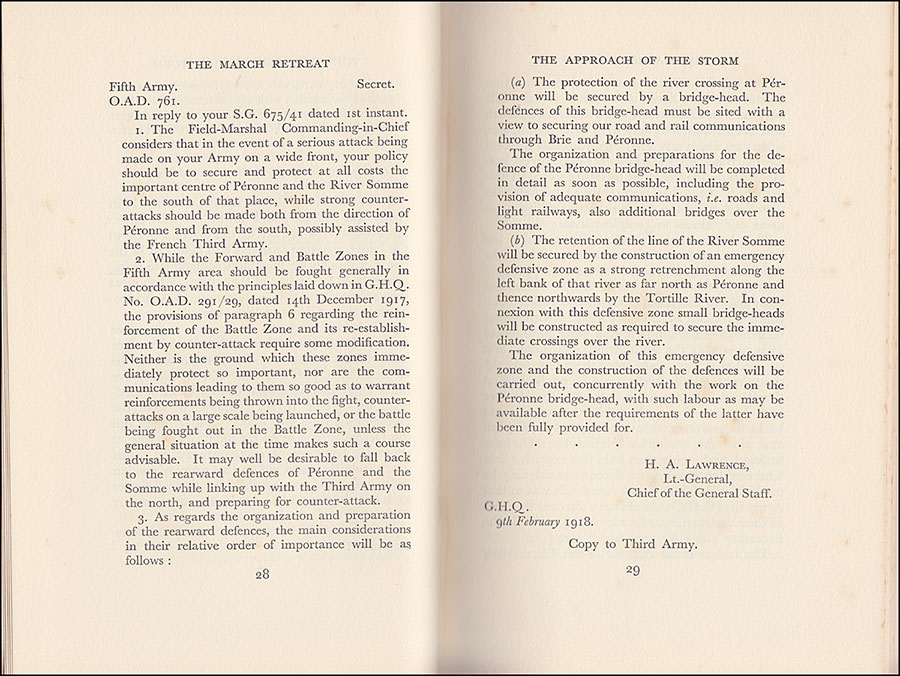
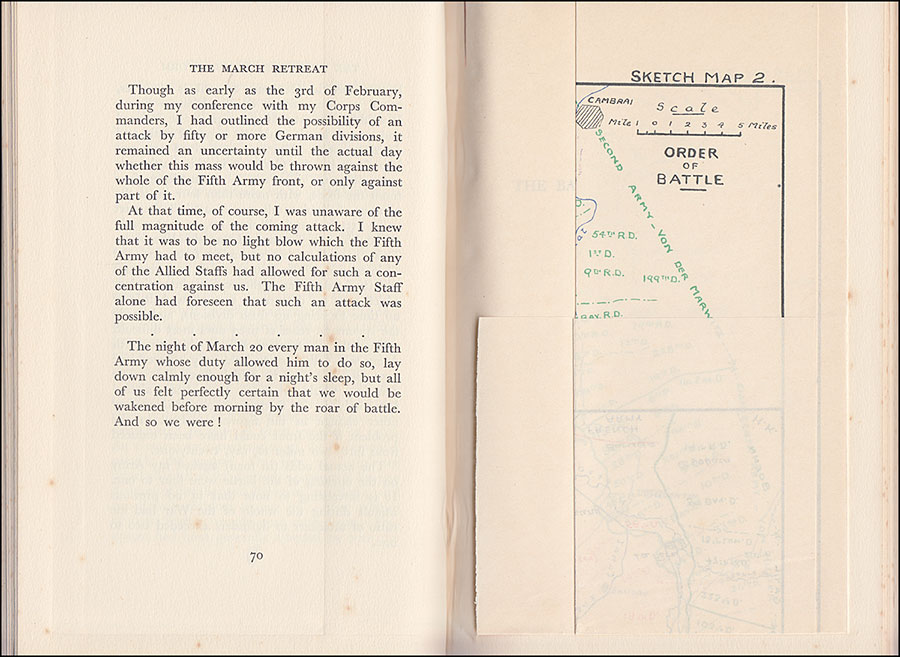
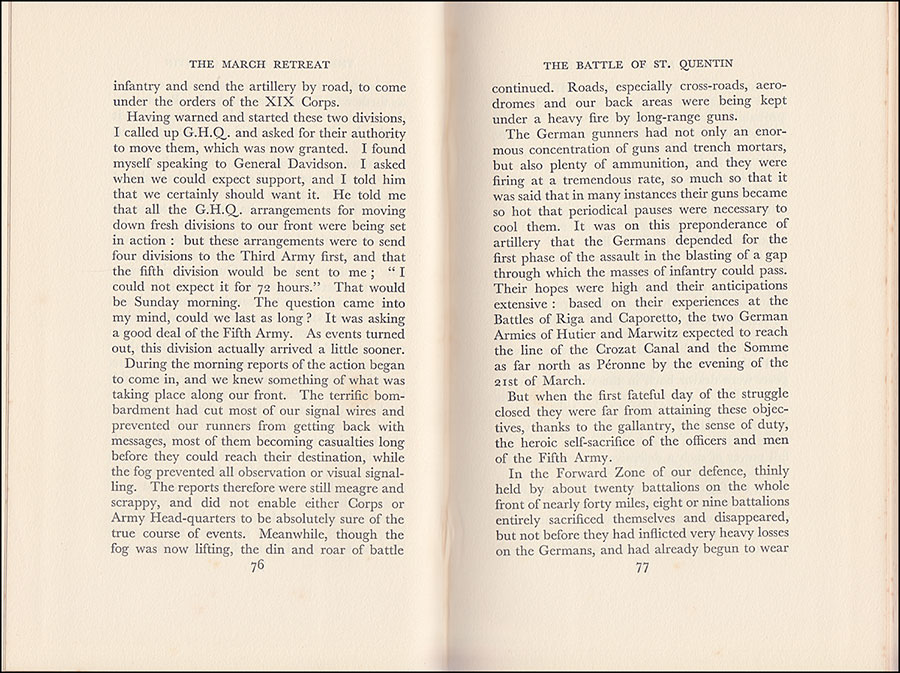
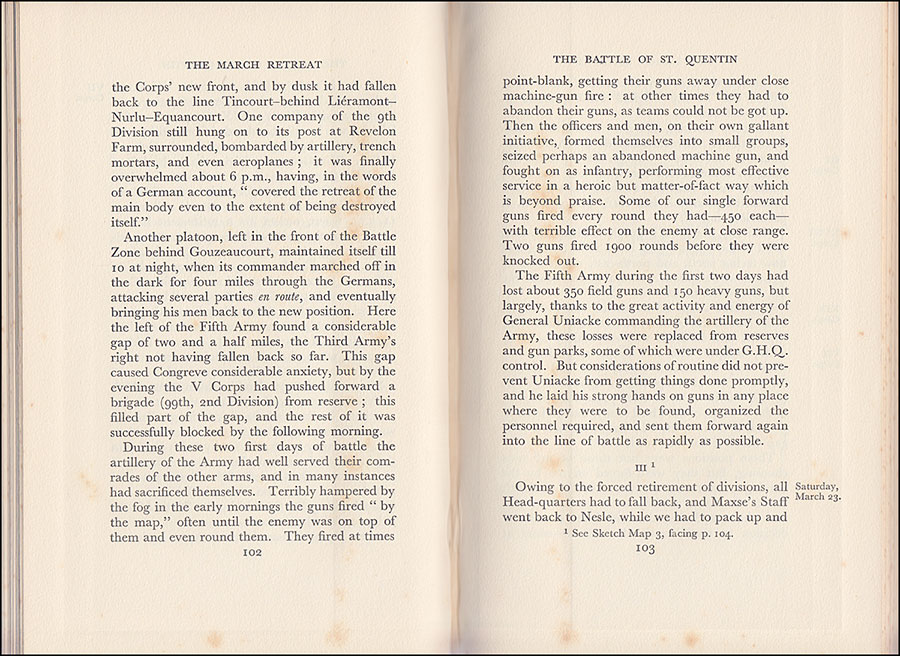
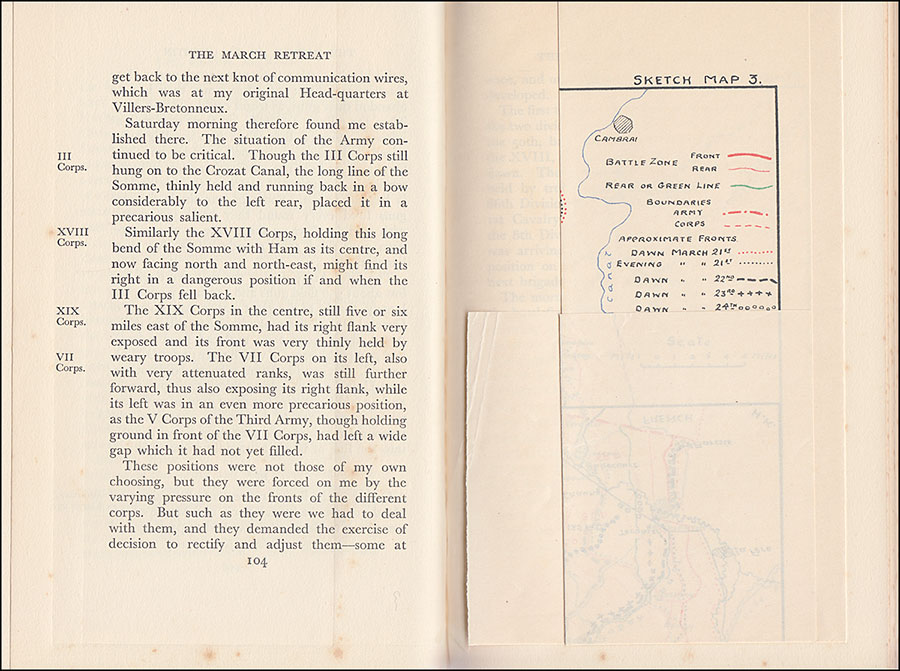
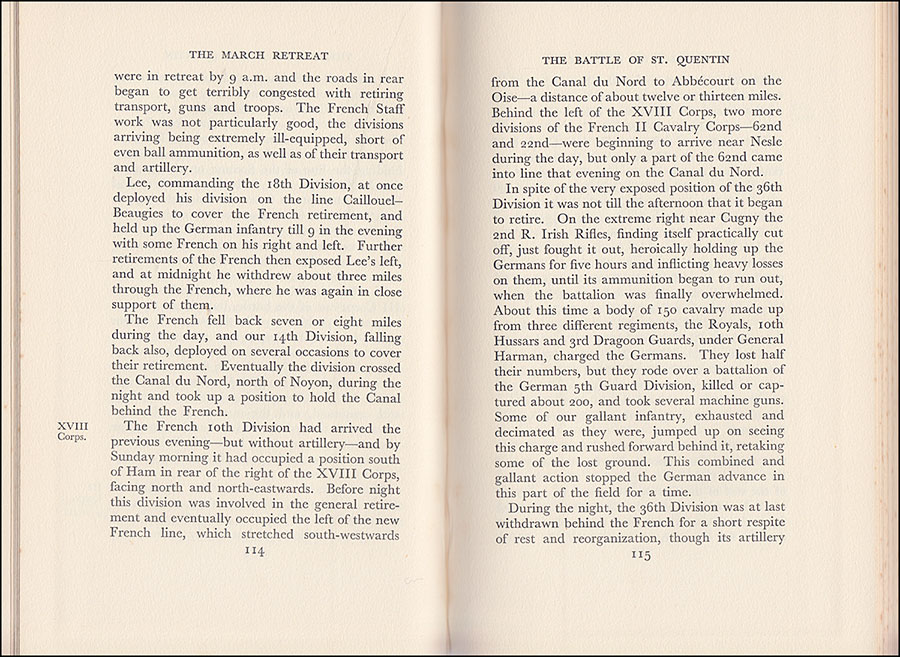
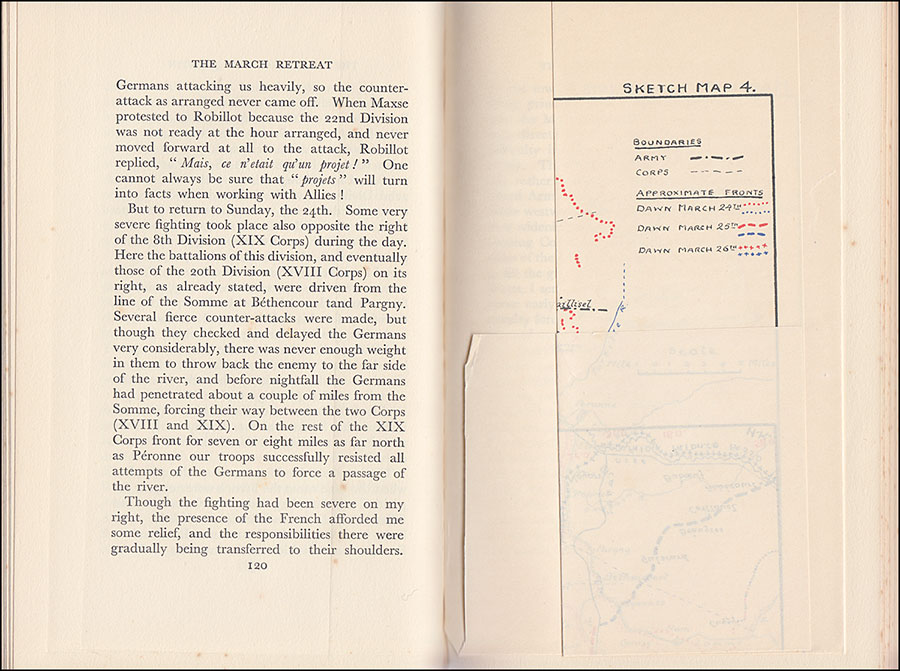
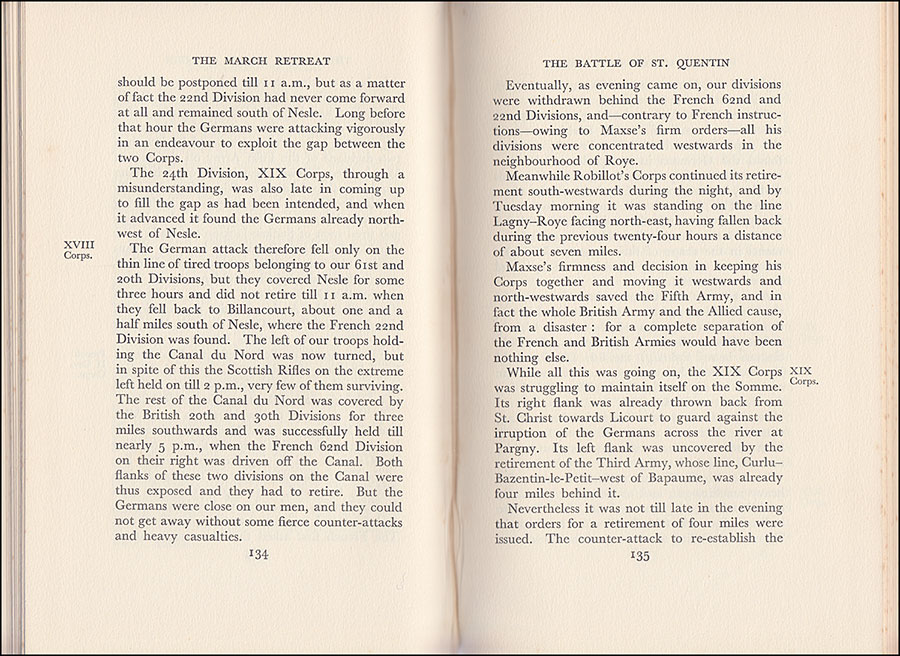
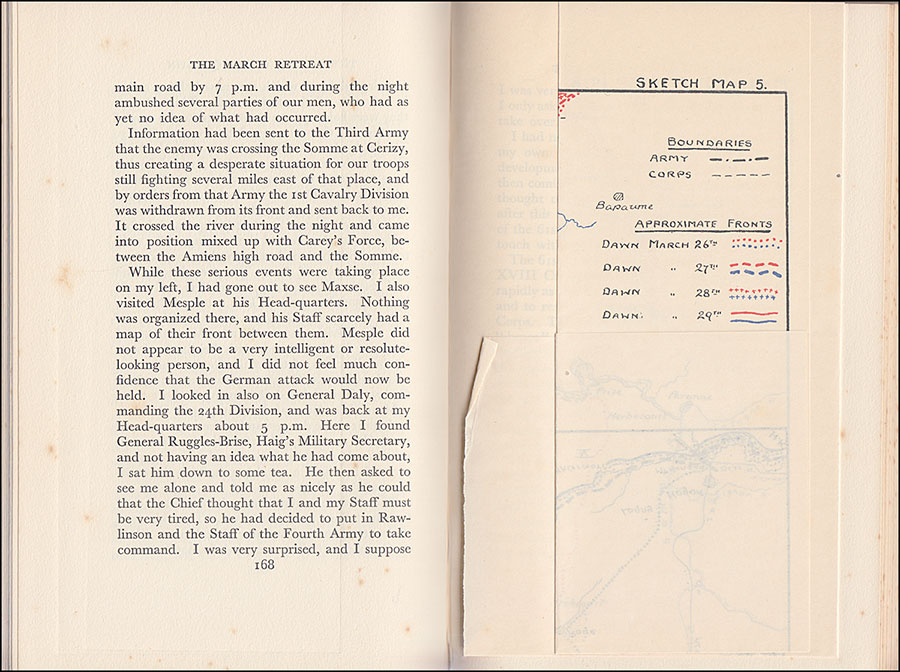
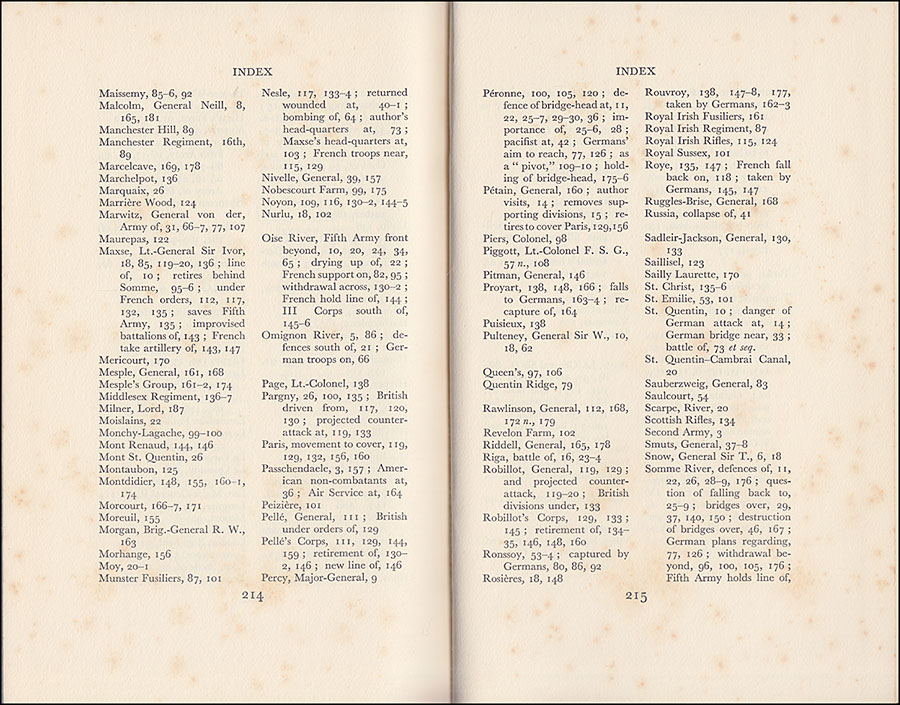
There is offsetting to the end-papers
(evenly-shaped areas of discolouration caused by the original
dust-jacket which is no longer present).
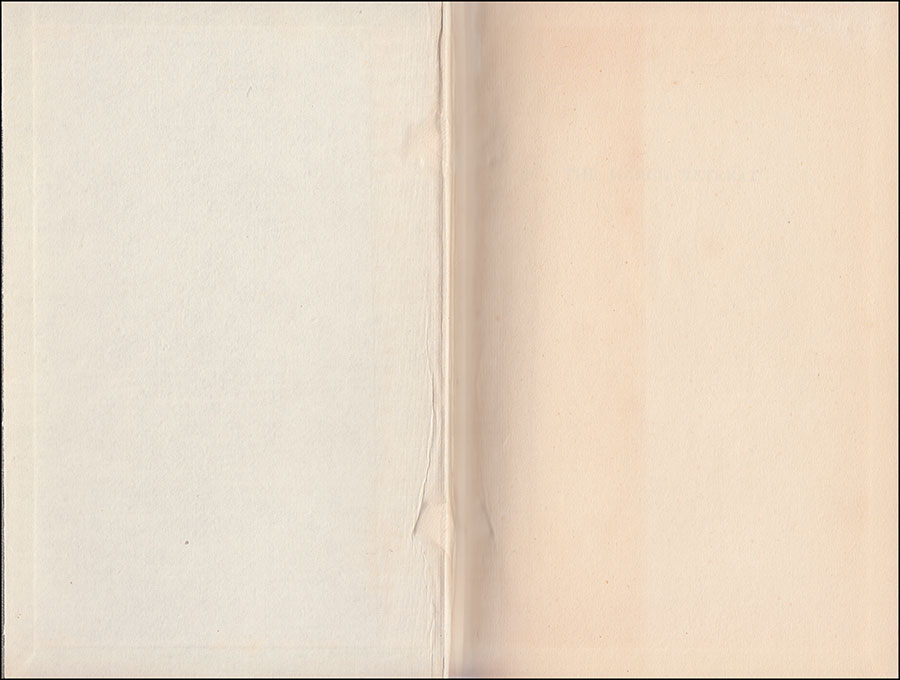
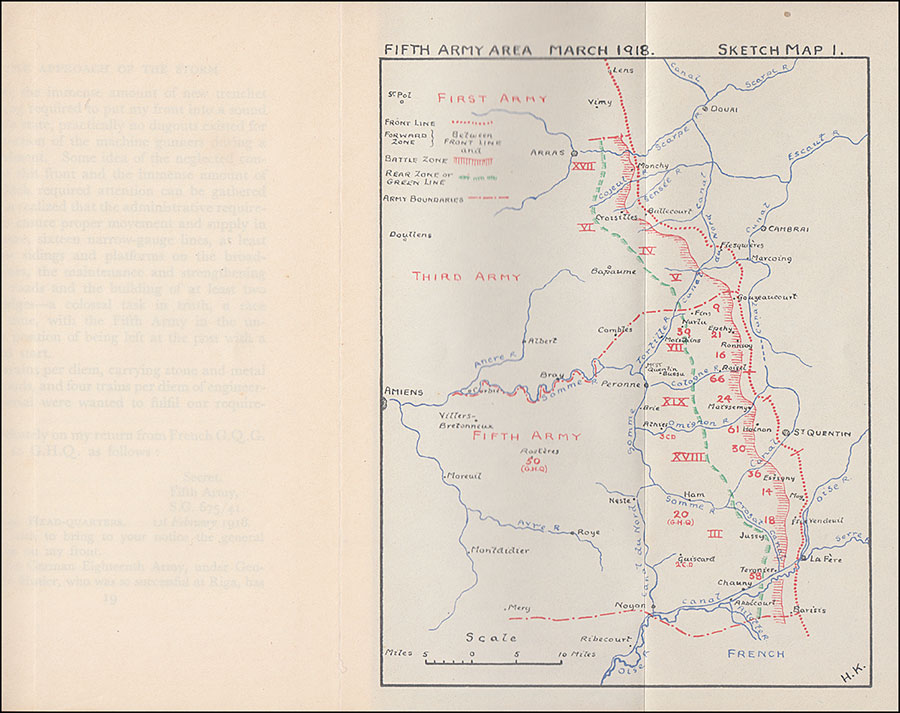
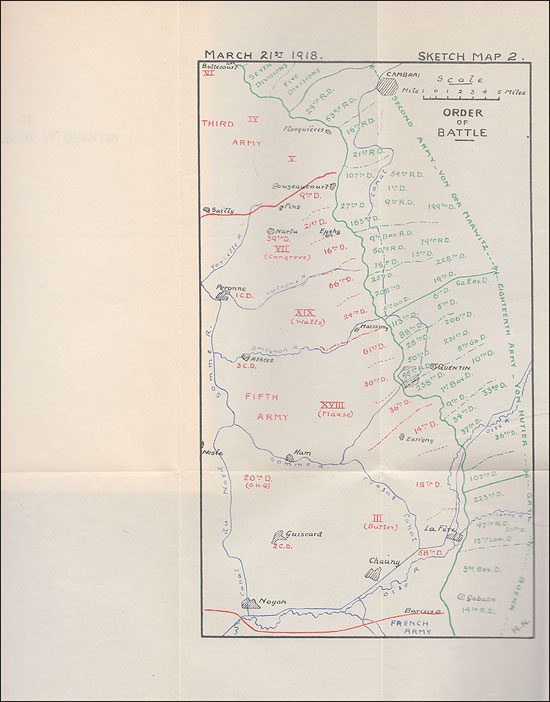
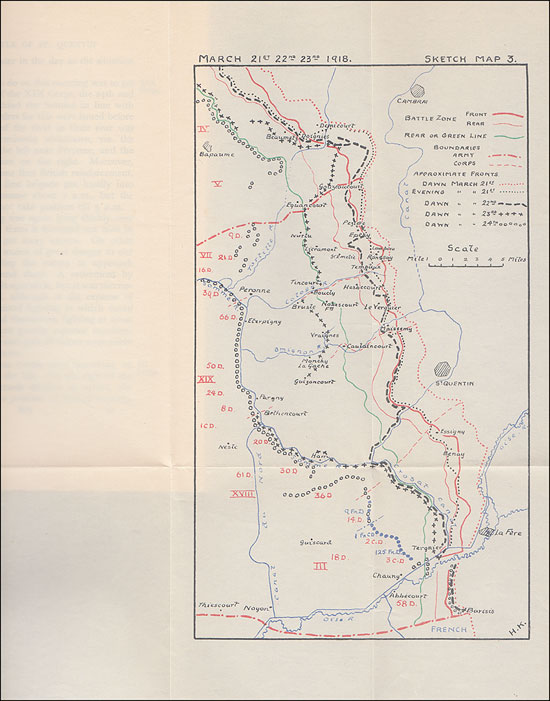
|
|
 |
|
 

|
 |
|
U.K. buyers:
|
To estimate the
“packed
weight” each book is first weighed and then
an additional amount of 150 grams is added to allow for the packaging
material (all
books are securely wrapped and posted in a cardboard book-mailer).
The weight of the book and packaging is then rounded up to the
nearest hundred grams to arrive at the postage figure. I make no charge for packaging materials and
do not seek to profit
from postage and packaging. Postage can be combined for multiple purchases. |
Packed weight of this item : approximately 500 grams
|
Postage and payment options to U.K. addresses: |
-
Details of the various postage options can be obtained by selecting
the “Postage and payments” option at the head of this
listing (above).
-
Payment can be made by: debit card, credit
card (Visa or MasterCard, but not Amex), cheque (payable to
"G Miller", please), or PayPal.
-
Please contact me with name,
address and payment details within seven days of the end of the
listing;
otherwise I reserve the right to cancel the sale and re-list the item.
-
Finally, this should be an
enjoyable experience for both the buyer and seller and I hope
you will find me very easy to deal with. If you have a question
or query about any aspect (postage, payment, delivery options
and so on), please do not hesitate to contact me.
|
|
 |
 |
|
International
buyers:
|
To estimate the
“packed
weight” each book is first weighed and then
an additional amount of 150 grams is added to allow for the packaging
material (all
books are securely wrapped and posted in a cardboard book-mailer).
The weight of the book and packaging is then rounded up to the
nearest hundred grams to arrive at the shipping figure.
I make no charge for packaging materials and do not
seek to profit
from shipping and handling.
Shipping can
usually be combined for multiple purchases
(to a
maximum
of 5 kilograms in any one parcel with the exception of Canada, where
the limit is 2 kilograms). |
Packed weight of this item : approximately 500 grams
| International Shipping options: |
Details of the postage options
to various countries (via Air Mail) can be obtained by selecting
the “Postage and payments” option at the head of this listing
(above) and then selecting your country of residence from the drop-down
list. For destinations not shown or other requirements, please contact me before buying.
Due to the
extreme length of time now taken for deliveries, surface mail is no longer
a viable option and I am unable to offer it even in the case of heavy items.
I am afraid that I cannot make any exceptions to this rule.
|
Payment options for international buyers: |
-
Payment can be made by: credit card (Visa
or MasterCard, but not Amex) or PayPal. I can also accept a cheque in GBP [British
Pounds Sterling] but only if drawn on a major British bank.
-
Regretfully, due to extremely
high conversion charges, I CANNOT accept foreign currency : all payments
must be made in GBP [British Pounds Sterling]. This can be accomplished easily
using a credit card, which I am able to accept as I have a separate,
well-established business, or PayPal.
-
Please contact me with your name and address and payment details within
seven days of the end of the listing; otherwise I reserve the right to
cancel the sale and re-list the item.
-
Finally, this should be an enjoyable experience for
both the buyer and seller and I hope you will find me very easy to deal
with. If you have a question or query about any aspect (shipping,
payment, delivery options and so on), please do not hesitate to contact
me.
Prospective international
buyers should ensure that they are able to provide credit card details or
pay by PayPal within 7 days from the end of the listing (or inform me that
they will be sending a cheque in GBP drawn on a major British bank). Thank you.
|
|
 |
 |
|

(please note that the
book shown is for illustrative purposes only and forms no part of this
listing)

Book dimensions are given in
inches, to the nearest quarter-inch, in the format width x height.
Please
note that, to differentiate them from soft-covers and paperbacks, modern
hardbacks are still invariably described as being ‘cloth’ when they are, in
fact, predominantly bound in paper-covered boards pressed to resemble cloth. |
|
 |
 |
|

Fine Books for Fine Minds |
I value your custom (and my
feedback rating) but I am also a bibliophile : I want books to arrive in the
same condition in which they were dispatched. For this reason, all books are
securely wrapped in tissue and a protective covering and are
then posted in a cardboard container. If any book is
significantly not as
described, I will offer a full refund. Unless the
size of the book precludes this, hardback books with a dust-jacket are
usually provided with a clear film protective cover, while
hardback books without a dust-jacket are usually provided with a rigid clear cover.
The Royal Mail, in my experience, offers an excellent service, but things
can occasionally go wrong.
However, I believe it is my responsibility to guarantee delivery.
If any book is lost or damaged in transit, I will offer a full refund.
Thank you for looking.
|
|
 |
 |
|
Please also
view my other listings for
a range of interesting books
and feel free to contact me if you require any additional information
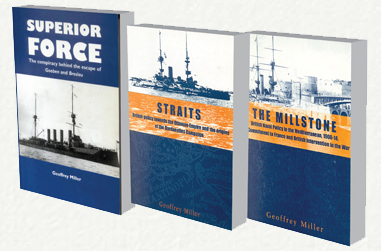

Design and content © Geoffrey Miller |
|
 |
|
|
|